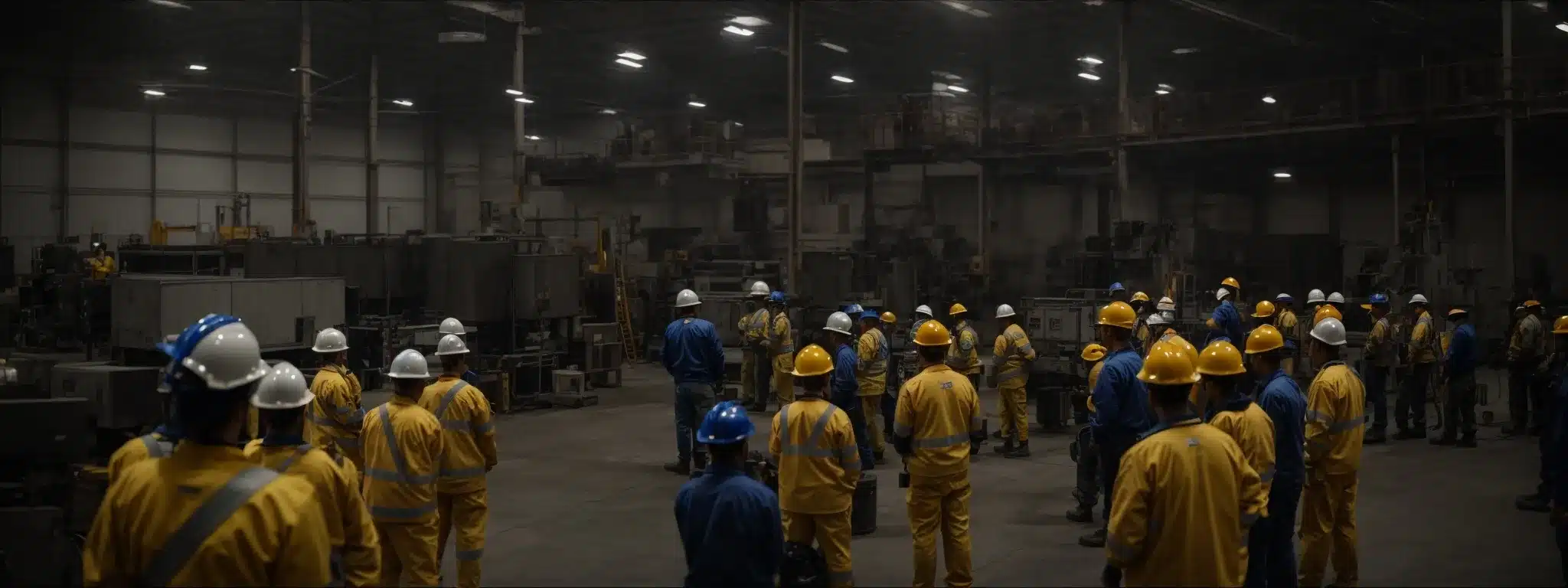Improving Employee Well-Being Through Enhanced Workplace Safety Initiatives
In any organization, making sure everyone stays safe and healthy isn’t just a nice idea—it’s a key part of keeping things running smoothly.
A workplace that’s free from hazards means workers can focus on their jobs without worry, and that’s good for everyone.
From cozy chairs that help your back to feeling like your boss has your back if a problem pops up, it’s all about creating a work environment where safety and health are top priorities.
Promoting such a culture not only prevents workplace injuries but also nourishes overall well-being.
Keep reading to discover how shaping a safety-conscious community at work can lead to happier and more productive teams.
Key Takeaways
- Worker Safety and Well-Being Are Central to a Resilient Work Environment
- Proactive Risk Assessments and Safety Protocols Help to Prevent Workplace Accidents and Injuries
- Employee Involvement and Feedback Are Crucial in Refining Safety Measures and Enhancing the Work Environment
- Regular Training and Emergency Preparedness Are Essential for Effective Response to Unforeseen Events
- Comprehensive Wellness Initiatives That Include Mental and Physical Health Contribute to a Robust Safety Culture
Crafting a Comprehensive Workplace Safety Plan

In the quest for a thriving work environment, the safety and well-being of every worker stand as pivotal concerns.
An organization’s commitment to safeguarding its team paves the way for a resilient safety culture—one that not only shields against workplace injuries but also fortifies the very foundations of worker health.
Initiating this transformative journey involves a multistep strategy, kicking off with a thorough risk assessment to spot potential workplace hazards.
Formulating precise safety protocols and initiating procedures form the bedrock of this approach, followed by the roll-out of dynamic educational programs designed to embed occupational safety and health knowledge among employees.
A keystone in this framework is the integration of worker insights, ensuring safety measures resonate with those on the front lines.
To stay ahead of evolving working conditions, leaders view the safety plan as a living document, consistently seeking refinements to keep the safety net robust and responsive.
This introductory road map sets the stage for a deeper discussion into nurturing employee safety and a proactive health administration within any workplace.
Assessing Risks and Hazards in the Workplace
Embarking on the journey of mitigating workplace accidents commences with a meticulous risk assessment. This crucial step empowers safety practitioners to recognize and categorize potential threats that could lead to injuries and illnesses among employees. It’s the foundation of any robust safety program, assisting institutions like the Occupational Safety and Health Administration (OSHA) and companies to preemptively thwart incidents before they occur.
Following the identification process, an organization often conducts an investigation to understand the intricate workings and potential fail points within its facility. Leaders partner with experts to analyze the environment, zeroing in on anything from equipment malfunctions to health conditions that could impede employee safety. This proactive inspection keeps the workplace aligned with health and safety standards, championing the cause of a hazard-free work environment.
Establishing Clear Safety Protocols and Procedures
Once the risks are understood, crafting clear safety protocols becomes imperative for organizations. The design of these procedures is tailored to address the unique challenges of the worksite, equipping workers with clear guidance on how to navigate potential dangers and respond to accidents efficiently and effectively.
Through the careful implementation of these protocols, companies affirm their dedication to preserving a secure workspace. It is through this commitment that they reinforce safety as a non-negotiable priority, ensuring that each employee understands their role within the framework of safeguarding their health and well-being.
Implementing Ongoing Employee Safety Training Programs
Imperative to fortifying workplace safety is the implementation of ongoing training programs. These education-focused initiatives keep employees abreast of current safety protocols and the responsibilities they carry in maintaining a secure work environment.
These efforts, led by seasoned safety leaders and practitioners, aim to transform the work environment into a hub of awareness and preventive action, drastically reducing the risk of workplace injuries and illnesses.
Integrating Employee Feedback Into Safety Measures
Ensuring workplace safety goes beyond regulations and training; it hinges on the lived experiences of employees. An insightful organization invites its workers to share their on-the-ground experiences, building upon the diverse perspectives to refine safety protocols and enhance the work environment for everyone involved.
By valuing worker feedback, a company demonstrates its respect for the very individuals it aims to protect, fostering a safety culture grounded in partnership and trust. This collaborative approach plays a crucial role in not only identifying unseen hazards but also in crafting measures that truly resonate with the workforce, ultimately reducing the risks of workplace accidents and injuries.
Regularly Reviewing and Updating the Safety Plan
Regular review and updates to the safety plan are crucial to ensuring its effectiveness in the changing landscape of workplace dynamics. As conditions shift and new equipment enters the supply chain, the organization must respond with a nimble and thorough review process:
- Conducting routine inspections to identify new hazards.
- Engaging with employees to gather feedback on safety measures.
- Assessing the impact of implemented safety protocols on worker health.
- Working alongside agencies like OSHA to integrate the latest safety standards.
- Training leaders and workers to handle upcoming safety challenges adeptly.
This ongoing process guarantees that safety protocols remain up-to-date, aligning with both regulatory expectations and the well-being of every employee. Leaders and safety practitioners play an essential role, working in tandem with workers to apply a proactive and collaborative approach to health and safety management.
Investing in Ergonomic Workspaces for Healthier Employees

At the heart of a robust workplace safety strategy lies the pursuit of creating an environment that not only prevents injuries but also promotes overall worker health.
When a company invests in ergonomic workspaces, it addresses a core aspect of workplace well-being by adapting the work environment to meet the physical needs of its employees.
Understanding the basics of ergonomic design, recognizing the distinct ergonomic needs across various job roles, introducing suitable furniture and equipment, and educating staff about ergonomic practices stand as critical touchpoints in this initiative.
These strategic moves are instrumental in augmenting employee comfort, thereby reducing the risk of workplace injury and enhancing employee well-being.
Evaluation of how such ergonomic interventions impact employees’ health is a testament to an organization’s dedication to continuous improvement in creating a work environment where every employee can thrive.
Understanding the Basics of Ergonomic Design
Ergonomic design is an evidence-based approach aiming to tailor the work environment to suit the physical needs of each employee. It revolves around modifying equipment, workstations, and tasks to enhance comfort, efficiency, and productivity, thereby addressing the determinant factors that contribute to workplace injury.
An expertly designed ergonomic setup focuses on reducing strain, preventing awkward positioning, and minimizing repetitive motions. By advocating for a work environment harmonized with the natural movements of the human body, employers take an essential step towards fostering worker health and curtailing the incidence of occupational injuries.
Identifying the Ergonomic Needs of Various Job Roles
Every job role presents unique challenges and ergonomic requirements. It is crucial for employers to recognize the specific needs of different positions, from those requiring prolonged standing to desk-bound tasks demanding hours of typing and mouse use.
Mapping out these varied ergonomic needs sets the groundwork for adaptive workplace design and Equipment Selection. This targeted approach ensures employees in all areas of the company experience reduced physical strain and benefit from a supportive work environment:
| Job Role | Ergonomic Need | Adaptive Solutions |
|---|---|---|
| Office Worker | Neutral wrist position | Ergonomic keyboards and adjustable chairs |
| Warehouse Operator | Lifting support | Weight-assist equipment and proper lifting training |
| Retail Associate | Comfortable footwear | Anti-fatigue mats and breaks to reduce standing time |
Once the nuances of each job function are identified, the company can tailor ergonomic adjustments effectively. This active response not only augments employee comfort but also significantly contributes to reducing the incidence of workplace injuries and health conditions.
Procuring Ergonomic Furniture and Equipment
To harness the benefits of ergonomic design, companies are becoming proactive in acquiring ergonomic furniture and equipment. This essential step directly influences the comfort and productivity of workers by supporting their physical health during work hours.
By prioritizing investment in ergonomic chairs, desks, and tools, employers contribute to the long-term wellness of their workforce. These purchases reflect a strategic commitment to reducing workplace hazard risks and enhancing overall job satisfaction and output:
- Selecting chairs that offer lumbar support and adjustability to cater to each employee’s body.
- Providing desks that enable easy height alterations for sitting or standing work preferences.
- Integrating tools designed with comfort grips and user-friendly interfaces to minimize muscular strain.
The implementation of such ergonomic resources signals an employer’s devotion to fostering a positive and health-centric work environment. Furthermore, it acknowledges the company’s role in contributing to the national effort of improving working conditions and employee health.
Educating Staff on Proper Ergonomic Practices
Employer-led workshops and hands-on demonstrations play a critical role in imparting proper ergonomic practices among staff. These sessions, grounded in expert advice, ensure that every member of the team understands how to adjust and utilize their workspace and equipment to prevent strain and maintain optimal health.
Supplementing these training endeavors, employers often provide visual aids and reminder materials throughout the facility, reinforcing the best ergonomic techniques. This constant encouragement aids employees in integrating healthy habits into their daily routines, reducing the likelihood of workplace injuries and boosting overall well-being.
Evaluating the Impact of Ergonomics on Employee Well-Being
An organization’s commitment to optimal ergonomic conditions has a direct impact on reducing the occurrence of musculoskeletal disorders among employees, such as back pain or carpal tunnel syndrome. This positive shift in worker health is typically measured through reduced reports of discomfort and a decline in workplace injury incidents.
With these healthful changes in place, employers often witness an upsurge in productivity as well as a boost in overall employee morale. Tracking these improvements serves as a vital indicator of the success of ergonomic interventions, underlining their importance in fostering a health-centric and efficient work environment:
- Monitor changes in employee health reports before and after ergonomic improvements.
- Review statistics of workplace injury rates to assess the impact of ergonomic changes.
- Survey employee satisfaction levels to gauge the perceived effectiveness of the new ergonomic conditions.
Mental Health Matters: Supporting Emotional Safety at Work

The push for a safer workplace doesn’t stop at physical well-being; it also encompasses the mental and emotional health of employees.
Leaders within an organization must acknowledge that the work environment plays a crucial role in shaping the mental state of its workers.
From recognizing the early warning signs of stress and burnout to ensuring access to mental health resources and fostering open discussions about emotional concerns, a comprehensive approach to employee well-being is necessary.
Organizations must also focus on developing work-life balance programs and equipping managers with the skills to address mental health issues effectively.
These steps are essential for cultivating a supportive atmosphere that values each employee’s mental health as a key component of workplace safety and overall success.
Recognizing the Signs of Workplace Stress and Burnout
Company leaders have a significant role in discerning the early manifestations of stress and burnout among their teams. Subtle changes in performance, increased absenteeism, or shifts in behavior may signal that an employee is grappling with stress, potentially escalating to burnout if unaddressed.
Employers have the responsibility to create a responsive work environment where signs of emotional distress are not only noticed but also promptly acted upon. Training managers to recognize and respond to these indicators forms the core of an organization’s commitment to maintaining not just physical, but also mental and emotional, workplace safety.
Providing Access to Mental Health Resources and Support
Ensuring the mental health of a workforce requires providing access to appropriate resources and support systems. An employer demonstrates commitment to this aspect of health and safety by integrating mental health services and counseling opportunities within their wellness programs.
Proactive measures include creating partnerships with health professionals and institutions specializing in mental well-being. Such collaborative efforts pave the way for a support network that is both accessible and equipped to handle a wide array of emotional and psychological concerns:
| Resource Type | Objective | Outcome for Employees |
|---|---|---|
| In-house Counseling Services | Provide immediate, confidential support | Accessible emotional care within the workplace |
| External Mental Health Partnerships | Offer professional, specialized assistance | Diverse options for personalized care |
| Online Support Platforms | Facilitate 24/7 assistance for employees | Constant availability for crisis management and guidance |
By embedding mental health resources into the fabric of workplace safety initiatives, organizations foster an environment that attends to the holistic needs of their employees. With these resources, employees are empowered to seek help when needed, promoting a healthier, more resilient workforce.
Encouraging Open Dialogue About Mental Health Issues
An organization thrives when it fosters a climate where workers feel secure to voice mental health concerns without fear of judgment or repercussion. Leaders must establish and promote channels for open, candid discussions, effectively dismantling the stigma surrounding mental health that can hinder honest conversations.
Facilitating such a communicative atmosphere underscores a company’s recognition of mental well-being as an integral element of workplace safety. This strategy enables employers to become allies in their employees’ pursuit of mental and emotional well-being, demonstrating a deep-rooted commitment to nurturing a supportive and health-conscious work environment.
Developing Programs for Work-Life Balance
Creating a balance between work and personal life is essential for maintaining employee well-being. Companies increasingly implement programs that encourage flexible scheduling and remote working options to accommodate the diverse life circumstances of their workforce.
These initiatives allow employees to better manage their time and reduce stress, thereby fostering an environment where both personal and professional growth can flourish. Managers play a pivotal role by modeling this balance and supporting their team’s efforts to integrate work with life’s other responsibilities:
| Program Type | Benefit to Employees | Company Outcome |
|---|---|---|
| Flexible Work Hours | Alleviates stress from rigid schedules | Increases job satisfaction and retention |
| Remote Work Options | Eliminates long commutes, enhances autonomy | Expands talent pool, boosts productivity |
| Wellness Leave Policies | Encourages mental health breaks | Promotes a healthy, engaged workforce |
Training Managers to Handle Mental Health Concerns
Equipping managers with the skills to address mental health concerns is a fundamental step in bolstering workplace safety. By offering specialized training, leaders in an organization equip these frontline figures with the capacity to sustain an empathetic dialogue with distressed employees while guiding them towards available support services.
Managerial training programs that focus on mental health awareness create an environment where issues can be addressed proactively rather than reactively. This preparation not only aids managers in navigating sensitive conversations but also instills confidence in employees, fostering a work culture where mental well-being is prioritized as part of comprehensive employee care.
Emergency Readiness: Preparing Employees for the Unexpected

Ensuring the well-being and safety of employees extends beyond everyday scenarios, reaching into the realm of emergency preparedness where the unexpected lurks.
A strategic focus on emergency readiness is critical for instilling a sense of security amongst workers and equipping them for various unplanned situations.
By creating a comprehensive emergency response plan, conducting regular drills and simulations, establishing a robust communication system for crises, adequately equipping the workplace with essential safety gear, and clearly assigning roles during emergency events, organizations take significant strides in safeguarding their most valuable assets—their employees.
These proactive measures are vital to the overall safety initiative, reinforcing the employer’s resolve to protect and prepare the workforce against any potential threats that may arise.
Creating a Thorough Emergency Response Plan
A comprehensive emergency response plan is an employer’s blueprint for action during crisis situations, detailing precise steps to protect workers and manage incidents efficiently. This plan customizes protocols to address specific risks inherent to a company’s operations, ensuring a swift, coordinated, and effective response that prioritizes worker safety above all else.
Critical components for this type of plan include clear evacuation routes, designated safe areas, and specific roles assigned to trained employees tasked with guiding their colleagues to safety. Organizations that methodically prepare for emergencies demonstrate an unwavering commitment to maintaining a secure and prepared work environment.
Conducting Regular Emergency Drills and Simulations
Regular emergency drills and simulations are not just a procedural formality but a critical practice to ensure that when unexpected events occur, employees can respond swiftly and effectively. By exposing workers to scenarios that mimic real-life emergencies, organizations empower their teams with the confidence and skills necessary to navigate crises.
Simulations bring a practical edge to theoretical safety plans, enabling employees to identify and rectify potential gaps in emergency procedures. Workers learn to act decisively, whether it’s executing an evacuation strategy or utilizing emergency equipment, transforming written protocols into actionable knowledge.
| Emergency Drill Type | Primary Focus | Objective |
|---|---|---|
| Fire Evacuation | Safe and quick exit strategies | Minimize time to evacuate, accounting for varied mobility needs of employees |
| Severe Weather | Shelter-in-place procedures | Ensure staff can locate and use designated safe zones |
| Medical Emergency | First-aid response | Empower employees to provide immediate assistance while awaiting professional help |
Establishing an Effective Communication System for Crises
An effective communication system is essential in a crisis, acting as the linchpin for a coordinated response. Employers are tasked with ensuring that every team member is informed swiftly and accurately, even in the throes of an emergency, underscoring the importance of a well-established communication protocol.
In the fabric of workplace safety initiatives, leaders develop and integrate advanced communication technologies. These tools are geared to disseminate instructions clearly and keep the lines open between all levels of an organization, ultimately safeguarding employee well-being in times of crisis.
Equipping the Workplace With Necessary Safety Gear
Strengthening emergency readiness in the workplace includes ensuring that appropriate safety gear is readily available and accessible to all employees. This equipment serves as a critical line of defense in the event of an unforeseen incident, enabling workers to protect themselves effectively until help arrives.
Employers must regularly evaluate and update emergency equipment to maintain a high standard of preparedness. This consistent review and replenishment ensure that the safety gear meets current industry standards and is in optimal condition should an emergency transpire.
- Analyze the specific safety gear required for different emergency scenarios within the workplace.
- Implement a system for regular inspection and maintenance of the emergency equipment.
- Train employees on the proper use and location of the safety gear to enhance workplace hazard response.
Assigning Roles and Responsibilities for Emergency Situations
In any emergency, identifying who does what is critical to the safety and security of employees. An organization bears the responsibility to meticulously assign roles to team members, ensuring they are coached to execute emergency tasks adeptly, whether that includes contacting emergency services or guiding colleagues to safety zones.
This structured assignment of responsibilities gives every employee a clear understanding of how to act without hesitation, bestowing upon them an integral role in the collective effort to manage unexpected workplace events. The employer’s directive to organize and train staff for these roles spotlights the value placed on protecting every worker from unforeseen dangers.
Promoting Health With Workplace Wellness Initiatives

A robust workplace safety agenda extends from the prevention of physical hazards to promoting overall employee well-being through comprehensive wellness initiatives.
These programs are crafted with a deep understanding of the diverse needs of the workforce and aim to enable healthier, happier, and more productive employees.
By offering on-site fitness resources, wellness challenges, and health services, companies underscore their investment in the complete health spectrum of their staff.
Prevention, too, takes center stage, with preventative health screenings forming a proactive approach to employee care.
Measuring the impact of these wellness programs is just as critical, providing valuable insights for adjusting strategies to ensure the initiatives effectively bolster employee health and workplace safety.
Designing a Tailored Workplace Wellness Program
A company embarks on curating a workplace wellness program by taking into profound consideration the specific requirements and preferences of its workforce. The crux of the program’s design hinges on addressing the unique health risks associated with various job roles, ensuring that health interventions are as personalized and effective as possible.
Through collaboration with health experts and employee surveys, organizations are able to pinpoint the most beneficial wellness services and activities that resonate with staff members. This bespoke approach to wellness programs exhibits an employer’s genuine commitment to cultivating a healthier, more engaged, and productive workforce by prioritizing their distinct well-being needs.
Offering on-Site Fitness and Health Facilities or Programs
Employers enhance the vitality of their workforce by providing on-site fitness and health facilities or programs, fostering an atmosphere that encourages physical activity and wellness throughout the workday. This proactive step helps to seamlessly integrate healthful habits into daily routines, contributing to reduced downtime and promoting a vibrant, energized employee base.
Accessibility to on-site programs minimizes barriers for employees wishing to pursue a healthier lifestyle, with the convenience of in-house facilities serving as a springboard for regular exercise and wellness engagement. This strategic commitment not only aids in employee retention but also underscores a company’s dedication to supporting a holistic approach to its employees’ well-being.
Organizing Wellness Challenges and Incentives
Employers can foster a dynamic sense of camaraderie and healthy competition through wellness challenges, effectively promoting physical and mental well-being among staff. These challenges can range from step-counting competitions to mindful meditation sessions, often accompanied by rewards or recognition to incentivize participation.
The provision of incentives, be they in the form of bonuses, extra vacation days, or wellness vouchers, acts as a powerful motivator for employees to engage earnestly in these wellness initiatives. Such rewards highlight an organization’s investment in its employees’ health, leading to positive outcomes in both individual well-being and collective workplace morale.
Including Preventative Health Screenings and Services
Preventative health screenings and services are a company’s strategic tool to detect and mitigate potential health issues before they escalate into significant concerns. They underscore an employer’s proactive stance in managing employee health, ultimately contributing to a reduction in workplace accidents and illnesses.
Pioneering employers recognize the value of these health screenings as a critical component of comprehensive wellness programs, offering regular check-ups for vital health indicators such as blood pressure and cholesterol levels. Such measures serve not only to protect employees but also to foster a culture of health awareness within the workplace.
Assessing the Success of Wellness Initiatives on Employee Health
Tracking the effectiveness of wellness initiatives demands careful observation of their impact on employee health. An organization gauges success by reviewing changes in absenteeism rates, healthcare costs, and worker productivity post-implementation, using these metrics as indicators of improved health resulting from the programs.
In addition, collecting employee feedback through surveys or health assessments provides qualitative data that reveal personal experiences with the wellness programs. This feedback offers valuable insights into the programs’ efficacy, allowing the company to fine-tune its approach for even greater benefits to employee health and workplace safety.
Fostering a Culture of Safety: Engagement and Accountability

A safe and healthy workplace is not solely shaped by the implementation of rules and equipment; it is cultivated through a collective mindset where every employee, from management to the front lines, actively participates in perpetuating a culture of safety.
This evolving ethos hinges on leadership exemplifying safe practices, acknowledging and incentivizing the maintenance of high safety standards, fostering mutual responsibility among peers, ensuring a platform exists for raising safety concerns discreetly, and observing progress through the celebration of safety achievements.
Together, these actions coalesce to reinforce the shared value of workplace well-being, steering the entire team towards a space where safety and health are as natural as the work itself.
Leading by Example: Management’s Role in Safety Culture
Managers and leaders form the cornerstone of a safety-oriented culture, their actions and attitudes setting a powerful precedent throughout the organization. When they adhere to safety protocols and actively engage in risk assessments, they validate the importance of workplace safety, simultaneously inspiring employee confidence and commitment to these practices.
Influential leaders not only implement safety strategies but also actively participate in emergency drills and incident investigations: Their visible commitment is a clear and compelling message that safety is a priority at every level of the organization.
- Leaders uphold safety protocols, visibly committing to workplace well-being.
- Managers engage in risk assessments, reinforcing the importance of proactive safety measures.
- Involvement in drills and incident responses by the leadership team highlights an organization-wide commitment to safety.
Recognizing and Rewarding Safe Workplace Behavior
An organization’s decision to recognize and reward safe workplace behavior plays a pivotal role in reinforcing a safety culture. Highlighting individuals and groups who consistently adhere to safety protocols and contribute smart suggestions for improving the work environment sends a powerful message across the company.
Rewards for exceptional safety performance can take many forms, from public acknowledgment during company meetings to offering tangible incentives like bonuses or extra vacation days. These gestures of appreciation validate the collective efforts that go into maintaining a secure and health-conscious workplace, promoting a cycle of positive reinforcement that encourages ongoing vigilance and responsibility.
Encouraging Peer-to-Peer Safety Accountability
Building a robust safety culture extends into the realm of co-worker interactions, where employees are key players in observing and uplifting safety measures. By actively engaging in mutual vigilance, workers create a community of accountability, where everyone feels responsible for the well-being of their colleagues. This peer-driven oversight becomes a dynamic force, steering the collective consciousness toward utmost safety diligence.
In this atmosphere of shared commitment, employees are more likely to speak up and act when they spot a coworker bypassing safety protocols or identify a new hazard. Such immediate peer-to-peer intervention is a vital line of defense against accidents, embedding the principles of workplace safety into the fabric of daily operations. The organization benefits from a proactive workforce, empowered to take swift action that upholds the highest standards of safety and health.
Providing Channels for Reporting Safety Concerns Anonymously
Offering workers the means to share safety concerns without revealing their identity is a vital part of fostering a strong safety culture. Anonymous channels encourage openness, allowing issues to be raised that might otherwise remain hidden due to fear of repercussions.
This system of confidential reporting underscores an organization’s recognition of employee voices as a critical asset in the risk assessment and mitigation process. By prioritizing anonymity, a company establishes trust and demonstrates a genuine commitment to improving the work environment:
- Enable employees to report incidents discreetly, fostering a transparent atmosphere.
- Empower workers to contribute to safety without concern for personal conflict.
- Facilitate the early identification of potential risks leading to a safer workplace.
Celebrating Safety Milestones and Improvements
Acknowledging advancements in workplace safety steers an organization toward continued vigilance and success. These recognitions take shape through celebrations of safety milestones, where a company’s achievements in reducing workplace injury rates or successfully implementing new safety protocols are highlighted for all employees to see.
Such celebrations boost morale and underscore the organization’s unyielding pursuit of a safer work environment. Month-long records without incidents, successful emergency drills, or commendable updates to safety equipment can spark collective pride and reinforce the critical nature of each employee’s contribution to the safety culture:
- Highlight improvements in implementing safety protocols effectively.
- Emphasize the successful roll-out of health and safety trainings.
- Recognize periods with zero workplace accidents or injuries.
- Applaud the proactive steps taken by employees to mitigate risks.







